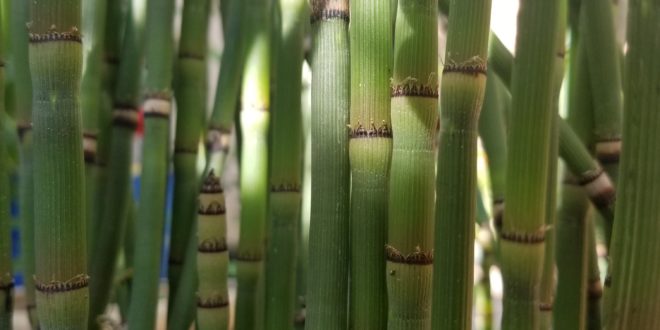Equisetum (horsetail, snake grass, scouring-rush, puzzlegrass) is the only living genus in Equisetaceae, a family of vascular plants that reproduce by spores rather than seeds. Native to North America.
Equisetum hyemale is a vigorous evergreen perennial with a striking vertical habit with multiple bamboo-like dark green stems arranged in dense clumps. Each stem has vertical ridges and is jointed or segmented. The nodes contain rings of tiny scale-like leaves and dark gray sheaths with black bands. The species is 2-4’ tall and 1-6’ wide.
t is strongly recommended to contain this plant because it aggressively spreads. In our Sunnyvale garden, we grow horsetail in one pot. It likes lots of water.
Equisetum naturally occurs in wet open woods, riparian zones of streams and rivers, shores of lakes and ponds, alluvial flats, springs, seeps, prairie swales, marshes, swamps, ditches, pastures and gravelly railroad right-of-ways.
Hardy from USDA Zones 4-9.
Occasionally fertile stems develop 1-2” yellowish or reddish spore bearing cones. The cones wither by late summer after the spores have been released.
CULTURAL & MAINTENANCE NEEDS: Equisetum hyemale thrives in sunny or shady sites with moist to wet soil. Plants adapt to sandy, gravelly, clay or saturated mucky soils and sites with shallow standing water or fluctuating water levels. This species tolerates drought and acid or alkaline soil.
In gardens, this aggressive plant should be confined with deep soil barriers or in pots without drainage holes. Rhizomes are extremely vigorous and have the ability to deeply penetrate the soil and grow under sidewalks or retaining walls.
LANDSCAPE USES: Equisetum hyemale is a pleasing Accent plant that is useful for Containers, Rain Gardens and Water Gardens. Plants provide Erosion Control and Winter Interest and are appropriate for Deer Resistant Plantings and Stormwater Management Projects. Plants should be sited with care, however, due to their penchant to escape and colonize unauthorized areas. This species is pest resistant and unpalatable to deer and other herbivores.
COMPANION & UNDERSTUDY PLANTS: In natural areas, Equisetum hyemale often occurs in monotypic stands. If confined in garden situations, it mingles nicely with Asclepias incarnata (milkweed), Lobelia cardinalis, Iris versicolor, Iris virginica and wetland sedges like Carex comosa.
TRIVIA:
- The pattern of spacing of nodes in horsetails, wherein those toward the apex of the shoot are increasingly close together, inspired John Napier to invent logarithms.
- Equisetum is a “living fossil”, the only living genus of the entire class Equisetopsida, which for over 100 million years was much more diverse and dominated the understory of late Paleozoic forests. Some Equisetopsida were large trees reaching to 30 meters tall.
- In certain types of light, the hollow stems appear to glow from within.
- Historically, due to a high silica content, the stems have been used to scour or polish wood and metal.








